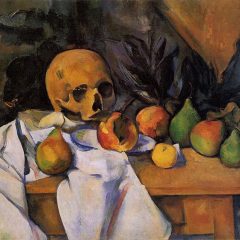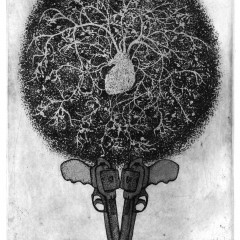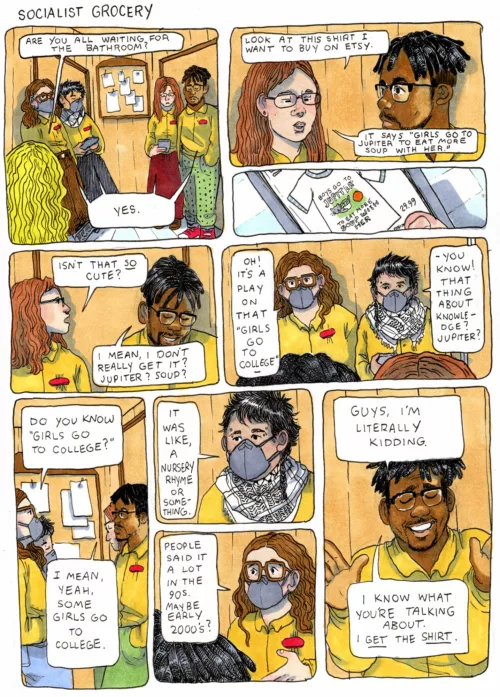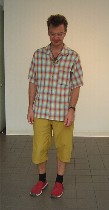 Here’s a picture of Brian Wallace flying his true colors Thursday night at Moore College. I had to share his great look.
Here’s a picture of Brian Wallace flying his true colors Thursday night at Moore College. I had to share his great look.Wallace, who’s the director of exhibitions there, was presiding over a closing reception for the two summer artists-in-residence in the galleries, one of those weekday events when it’s not clear that anyone is going to show up (some did).
The two artists–Jennifer Blazina and Elena Fajt–had spent the summer using the Levy and Paley Galleries at Moore as a hybrid studio/exhibition space. Fajt, in her show “More Hair?,” collected hair clippings that people donated and figured out a wide variety of ways to use them. Blazina, in her show “Re-Collect,” cast molds that incorporated old pictures.
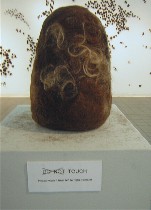 Hair, once it’s cut off a head, loses its bounce. It suggests loss and death and scalpings. And Fajt, who is Slovenian, recognizes that the material is, well, rather off-putting. In fact, some of the work directly confronts its transgressive nature, such as the piece that urges you to touch and move the hair pillar from one pedestal to the other. She even had a survey to collect people’s reactions to the use of hair (image, “/Do Not/ Touch”).
Hair, once it’s cut off a head, loses its bounce. It suggests loss and death and scalpings. And Fajt, who is Slovenian, recognizes that the material is, well, rather off-putting. In fact, some of the work directly confronts its transgressive nature, such as the piece that urges you to touch and move the hair pillar from one pedestal to the other. She even had a survey to collect people’s reactions to the use of hair (image, “/Do Not/ Touch”).
I recently had a conversation with a friend who lives in Hilo, and he was talking about the number of people who completely remove all their body hair, and all I could think of was how sad that people had become so visually cued, thanks to television and the movies, that they had forgotten about the pleasures of touch.
The bear-rug shapes suggested our affinity with animals and hair as fur. They also had a nice mappy quality up there on the wall. (To have put them on the floor would have been transgressive, indeed.)
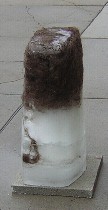 Fajt had a number of surprising moves in her use of hair, including freezing it in large blocks of ice that we got to watch melt. Here’s a piece like a capped ice-block bollard, out on the sidewalk. The indoor ice cube, with paper towels beneath to absorb the drips, was more demure and was named “Passing of Time/Ice.”
Fajt had a number of surprising moves in her use of hair, including freezing it in large blocks of ice that we got to watch melt. Here’s a piece like a capped ice-block bollard, out on the sidewalk. The indoor ice cube, with paper towels beneath to absorb the drips, was more demure and was named “Passing of Time/Ice.”For all the creativity, I came away looking for more content.
Blazina, who teaches at Drexel, had shown some work about a year ago at Spector Gallery. Since then, she has worked her way out of a crowd of tiny, portraits of the dead in tiny cast plaster frames that lacked the poetry needed to counteract the sense of lives dried, wasted and lost.
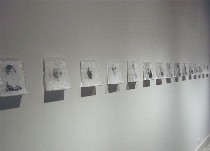 Blazina is still using the same labor-intensive process of combining screen prints she makes of old photographic portraits with casts of old picture frames. The work takes on greater interest with transparent media, the pictures embedded through thick layers of glass or rubber (image, “Class of 1940, cast glass, screen print, steel).
Blazina is still using the same labor-intensive process of combining screen prints she makes of old photographic portraits with casts of old picture frames. The work takes on greater interest with transparent media, the pictures embedded through thick layers of glass or rubber (image, “Class of 1940, cast glass, screen print, steel).
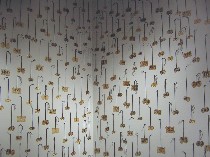 Her series filled the wall spaces with multiples. I especially liked the yearbook portraits under glass and the little room filled from floor to ceiling with splayed-open lockets. There was a sad claustrophobia in the tiny space with the yellowy-brown, rubber lockets. But the material was also funny. And the open lockets, unable to close and hold a secret love, reminded me of Mickey Mouse ears (image, “Memento Mori,” cast rubber, screen print, silk cord).
Her series filled the wall spaces with multiples. I especially liked the yearbook portraits under glass and the little room filled from floor to ceiling with splayed-open lockets. There was a sad claustrophobia in the tiny space with the yellowy-brown, rubber lockets. But the material was also funny. And the open lockets, unable to close and hold a secret love, reminded me of Mickey Mouse ears (image, “Memento Mori,” cast rubber, screen print, silk cord).By the way, look closely at that picture at the top of Wallace and you will see he’s got one of the lockets around his neck.
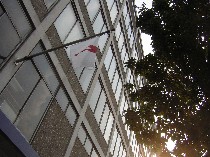 Outside, there’s a flag from Angie Evans that will fly until Aug. 12, then to be replaced by another artist’s contribution (Wallace isn’t telling whose, yet). The flags are part of a series called “Temporary Allegiance,” curated by Philip von Zweck. A small number of artists responded to the open call for submissions at this time when flag waving seems to be disturbing the peace. Each flag will hang for one week at a time and afterward, all the flags will be shown as a group. This one, named “What’s that Flag?” is a big question mark.
Outside, there’s a flag from Angie Evans that will fly until Aug. 12, then to be replaced by another artist’s contribution (Wallace isn’t telling whose, yet). The flags are part of a series called “Temporary Allegiance,” curated by Philip von Zweck. A small number of artists responded to the open call for submissions at this time when flag waving seems to be disturbing the peace. Each flag will hang for one week at a time and afterward, all the flags will be shown as a group. This one, named “What’s that Flag?” is a big question mark.





